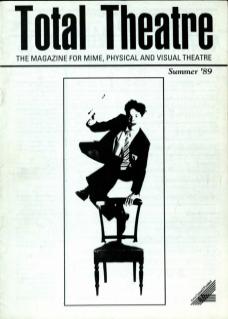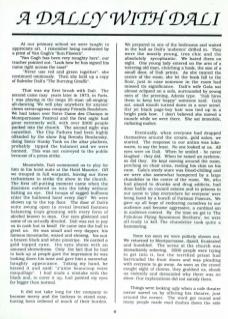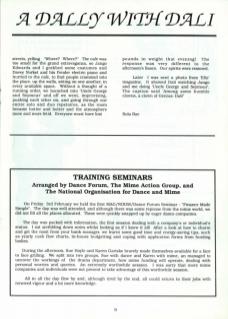At our primary school we were taught to appreciate art. I remember being confronted by a print of Van Gogh’s ‘Sun Flowers’.
‘Van Gogh has been very naughty here,’ our teacher pointed out. ‘Look how he has signed his name right across the vase!’
‘Never use red and green together,’ she continued ominously. Then she held up a copy of Salvador Dali’s ‘The Burning Giraffe’.
That was my first brush with Dali. The second came many years later in 1973, in Paris. I was playing in the mega 25-man all-singing-all-dancing ‘We will play anywhere for anyone’ clown extravaganza company Friends Roadshow. We had taken over Notre Dame des Champs in Montparnasse Festival and the first night had gone extremely well, with over 2000 people packed into the church. The second night was cancelled. The City Fathers had been highly offended by the show (big Brenda Besdansky, doing Sister Honky Tonk on the altar platform, probably tipped the balance) and we were banned. This was not conveyed to the public because of a press strike.
Meanwhile, Dali summoned us to play for him in his hotel suite at the Hotel Meurice. Off we trouped in full warpaint, leaving our three technicians to strike the show in the church. The first off-putting moment came when the doormen ushered us into the lobby without batting an eye. Did troupes of ragged buffoons enter the hallowed hotel every day? We were shown up to the top floor. The door of Dali’s suite swung open to reveal liveried footmen balancing trays groaning with every form of alcohol known to man. Our eyes glistened and some of us actually drooled. Dali was not to pay us in cash but in kind! He came into the hall to greet us. He was small and very dapper, his famous moustache, waxed and shining, his suit a brazen black and white pinstripe. He carried a gold topped cane. His eyes shone with an amused shrewdness. Only the fact that he had to look up at people gave the impression he was looking down his nose and gave him a somewhat haughty appearance. Taking my hand, he kissed it and said: ‘J'aime beaucoup votre maquillage.’ I had made a mistake with the black and, to cover it up, had painted my eyes far bigger than normal.
It did not take long for the company to become merry and the lackeys to stand easy, having been relieved of much of their burden. We prepared in one of the bedrooms and waited in the hall as Dali’s ‘audience’ drifted in. They were the mostly young, très chic and absolutely sycophantic. We hated them on sight. One young lady entered on the arm of a tottering old man, clutching a book, the size of a small door, of Dali prints. As she neared the centre of the room, she let the book fall to the floor, just in case someone in the room had missed its significance. Dali’s wife Gala sat almost eclipsed on a sofa, surrounded by young men of the preening Adonis type. ‘Dali hires them to keep her happy,’ someone said. Gala sat, small mouth turned down in a sour scowl. Her jet black page-boy hair was tied up in a bright pink bow. I don’t believed she moved a muscle while we were there. She sat immobile, radiating malice.
Eventually, when everyone had draped themselves around the ornate, gold salon, we started. The response to our antics was lukewarm, to say the least. No one looked at us. All eyes were on Dali. When he smiled – he never laughed – they did. When he raised an eyebrow, so did they. He kept moving around the room, perching on chair arms, resting his chin on his cane. Gala’s steely stare was blood-chilling and we were also somewhat hampered by a large chandelier in the centre of the room. We, who had played to drunks and drug addicts, had done battle on council estates and in prisons in our quest to ‘play everywhere for everyone’ were being fazed by a bunch of Parisian Poseurs. We gave up all hope of endearing ourselves to our audience and became aggressive, a cardinal sin in audience control. By the time we got to ‘The Fabulous Flying Spummoni Brothers’, we were all ready to kill. The chandelier took quite a hammering.
None too soon we were politely shown out. We returned to Montparnasse, dazed, frustrated and humbled. The scene at the church was immediately sobering. 2000 people were trying to get into it, but the terrified priest had barricaded the front doors and was pleading with everyone to go away. As soon as the crowd caught sight of clowns, they grabbed us, shook us violently and demanded why there was no show. Our explanations did not satisfy them.
Things were looking ugly when a cafe theatre owner saved us by offering his theatre, just around the corner. The word got round and many people made mad dashes down the side streets, yelling ‘Where? Where?’. The cafe was too small for the grand extravaganza, so Jango Edwards and I grabbed some costumes and Davey Norket and his Fender electric piano and hurried to the cafe, to find people crammed into the place, up the walls, sitting on one another, in every available space. Without a thought of a running order, we launched into ‘Uncle George and Seymour’ and off we went, improvising, pushing each other on, and going through our entire solo and duo repertoires, as the room became hotter and hotter and the atmosphere more and more fetid. Everyone must have lost pounds in weight that evening! The response was very different to the afternoon’s fiasco. Our spirits were restored.
Later I was sent a photo from Elle magazine. It showed Dali watching Jango and me doing ‘Uncle George and Seymour’. The caption said ‘Among some humble clowns, a clown of Genius: Dali’.


